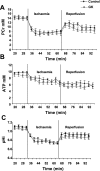Upregulation of eNOS and unchanged energy metabolism in increased susceptibility of the aging type 2 diabetic GK rat heart to ischemic injury
- PMID: 20729402
- PMCID: PMC2993220
- DOI: 10.1152/ajpheart.00998.2009
Upregulation of eNOS and unchanged energy metabolism in increased susceptibility of the aging type 2 diabetic GK rat heart to ischemic injury
Abstract
We investigated the tolerance of the insulin-resistant diabetic heart to ischemic injury in the male Goto-Kakizaki (GK) rat, a model of type 2 diabetes. Changes in energy metabolism, nitric oxide (NO) pathway, and cardiac function were assessed in the presence of physiological substrates. Age-matched control Wistar (n = 19) and GK (n = 18) isolated rat hearts were perfused with 0.4 mM palmitate, 3% albumin, 11 mM glucose, 3 U/l insulin, 0.2 mM pyruvate, and 0.8 mM lactate for 24 min before switching to 1.2 mM palmitate (11 rats/group) during 32 min low-flow (0.5 ml·min(-1)·g wet wt(-1)) ischemia. Next, flow was restored with 0.4 mM palmitate buffer for 32 min. A subset of hearts from each group (n = 8 for control and n = 7 for GK groups) were freeze-clamped for determining baseline values after the initial perfusion of 24 min. ATP, phosphocreatine (PCr), and intracellular pH (pH(i)) were followed using (31)P magnetic resonance spectroscopy with simultaneous measurement of contractile function. The NO pathway was determined by nitric oxide synthase (NOS) isoform expression and total nitrate concentration (NOx) in hearts. We found that coronary flow was 26% lower (P < 0.05) during baseline conditions and 61% lower (P < 0.05) during reperfusion in GK vs. control rat hearts. Rate pressure product was lower during reperfusion in GK vs. control rat hearts (P < 0.05). ATP, PCr, and pH(i) during ischemia-reperfusion were similar in both groups. Endothelial NOS expression was increased in GK rat hearts during baseline conditions (P < 0.05). NOx was increased during baseline conditions (P < 0.05) and after reperfusion (P < 0.05) in GK rat hearts. We report increased susceptibility of type 2 diabetic GK rat heart to ischemic injury that is not associated with impaired energy metabolism. Reduced coronary flow, upregulation of eNOS expression, and increased total NOx levels confirm NO pathway modifications in this model, presumably related to increased oxidative stress. Modifications in the NO pathway may play a major role in ischemia-reperfusion injury of the type 2 diabetic GK rat heart.
Figures






Similar articles
-
PPAR-alpha activation protects the type 2 diabetic myocardium against ischemia-reperfusion injury: involvement of the PI3-Kinase/Akt and NO pathway.Am J Physiol Heart Circ Physiol. 2009 Mar;296(3):H719-27. doi: 10.1152/ajpheart.00394.2008. Epub 2009 Jan 16. Am J Physiol Heart Circ Physiol. 2009. PMID: 19151258
-
Protective Effect of Resveratrol against Ischemia-Reperfusion Injury via Enhanced High Energy Compounds and eNOS-SIRT1 Expression in Type 2 Diabetic Female Rat Heart.Nutrients. 2019 Jan 6;11(1):105. doi: 10.3390/nu11010105. Nutrients. 2019. PMID: 30621358 Free PMC article.
-
Gender differences in hypertrophy, insulin resistance and ischemic injury in the aging type 2 diabetic rat heart.J Mol Cell Cardiol. 2004 Aug;37(2):547-55. doi: 10.1016/j.yjmcc.2004.05.014. J Mol Cell Cardiol. 2004. PMID: 15276024
-
Contribution of NO to ischemia-reperfusion injury in the saline-perfused heart: a study in endothelial NO synthase knockout mice.J Mol Cell Cardiol. 1999 Apr;31(4):827-36. doi: 10.1006/jmcc.1998.0921. J Mol Cell Cardiol. 1999. PMID: 10329210
-
Effects of Nitrate Intake on Myocardial Ischemia-Reperfusion Injury in Diabetic Rats.Arq Bras Cardiol. 2016 Oct;107(4):339-347. doi: 10.5935/abc.20160137. Arq Bras Cardiol. 2016. PMID: 27849257 Free PMC article.
Cited by
-
Obesity improves myocardial ischaemic tolerance and RISK signalling in insulin-insensitive rats.Dis Model Mech. 2013 Mar;6(2):457-66. doi: 10.1242/dmm.010959. Epub 2012 Nov 16. Dis Model Mech. 2013. PMID: 23161371 Free PMC article.
-
Metabolic Remodeling in Diabetic Cardiomyopathy.Cardiovasc Res. 2017 Mar 15;113(4):422-430. doi: 10.1093/cvr/cvx018. Epub 2017 Feb 8. Cardiovasc Res. 2017. PMID: 28177068 Free PMC article.
-
Sex Differences in Metabolic Cardiomyopathy.Cardiovasc Res. 2017 Mar 15;113(4):370-377. doi: 10.1093/cvr/cvx008. Epub 2017 Feb 1. Cardiovasc Res. 2017. PMID: 28158412 Free PMC article.
-
Perspectives of Targeting mTORC1-S6K1 in Cardiovascular Aging.Front Physiol. 2012 Jan 25;3:5. doi: 10.3389/fphys.2012.00005. eCollection 2012. Front Physiol. 2012. PMID: 22291661 Free PMC article.
-
Cardiac 31P MR spectroscopy: development of the past five decades and future vision-will it be of diagnostic use in clinics?Heart Fail Rev. 2023 Mar;28(2):485-532. doi: 10.1007/s10741-022-10287-x. Epub 2022 Nov 24. Heart Fail Rev. 2023. PMID: 36427161 Review.
References
-
- Aasum E, Hafstad AD, Severson DL, Larsen TS. Age-dependent changes in metabolism, contractile function, and ischemic sensitivity in hearts from db/db mice. Diabetes 52: 434–441, 2003 - PubMed
-
- Abdul-Ghani MA, DeFronzo RA. Mitochondrial dysfunction, insulin resistance, type 2 diabetes mellitus. Curr Diab Rep 8: 173–178, 2008 - PubMed
-
- Abdul-Ghani MA, Muller FL, Liu Y, Chavez AO, Balas B, Zuo P, Chang Z, Tripathy D, Jani R, Molina-Carrion M, Monroy A, Folli F, Van Remmen H, DeFronzo RA. Deleterious action of FA metabolites on ATP synthesis: possible link between lipotoxicity, mitochondrial dysfunction, and insulin resistance. Am J Physiol Endocrinol Metab 295: E678–E685, 2008 - PubMed
-
- Almind K, Dorio A, Kahn CR. Putting the genes for type II diabetes on the map. Nat Med 7: 277–279, 2001 - PubMed
-
- Bernard M, Caus T, Sciaky M, Lan C, Cozzone PJ. Optimized cardiac graft preservation: a comparative experimental study using P-31 magnetic resonance spectroscopy and biochemical analyses. J Heart Lung Transplant 18: 572–581, 1999 - PubMed
Publication types
MeSH terms
Substances
Grants and funding
LinkOut - more resources
Full Text Sources
Medical
Miscellaneous

